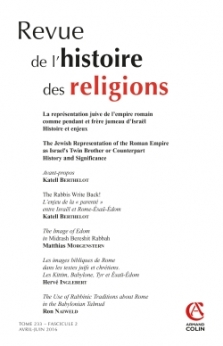
Revue de l'histoire des religions (2/2016)
Pour acheter ce numéro, contactez-nous
Recevez les numéros de l'année en cours et accédez à l'intégralité des articles en ligne.
Du iie siècle avant notre ère au ive siècle de notre ère, les Juifs ont décrit et compris Rome à travers les images bibliques des Kittim, de Babylone, de Tyr et d’Ésaü – Édom. Ce dernier thème devint prépondérant chez les Juifs rabbiniques, alors que les chrétiens des ier-ve siècles privilégièrent le parallèle avec Babylone. Cependant, le thème d’Ésaü – Édom est attesté chez deux auteurs chrétiens en contact avec des Juifs rabbiniques. On trouve les Romains comme fils d’Ésaü en 337 chez Aphraate, qui vivait en Mésopotamie sassanide. Et Jérôme, installé à Bethléem à la fin du ive siècle, signale, pour la rejeter, la théorie juive de l’identification des Romains à Édom dans ses commentaires exégétiques. Les sources chrétiennes peuvent ainsi aider à préciser les datations des textes rabbiniques.
Between the 2nd century BCE and the 4th century CE, Jews have described and understood Rome through the following biblical categories: the Kittim, Babylon, Tyre and Esau – Edom. The theme of Esau – Edom became predominant in rabbinic literature, whereas from the 1st to the 5th century, Christians tended to favour the parallel with Babylon. However, the theme of Esau – Edom does appear in the works of two Christian authors who were in touch with rabbinic Jews. The Romans are described as sons of Esau by Aphrahat, who lived in Sassanian Mesopotamia, as early as 337. Later on, Jerome, who lived in Bethleem at the end of the 4th century, mentions (and rejects) the Jewish identification of the Romans with Edom in some of his exegetical commentaries. Christian sources may therefore help to date the rabbinic tradition concerning the identification of Rome with Esau – Edom more precisely.

